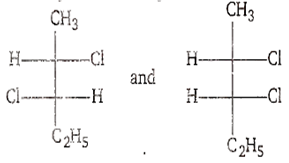 Multiple Choice Questions
Multiple Choice QuestionsDisymmetric object is one which is:
superimposable on its mirror image
non-superimposable on its mirror image
optically inactive
achiral
To differentiate between carbon-12, carbon-13 and carbon-14, the instrument that you would use is :
infra-red spectrometer
atomic absorption spectrometer
mass spectrometer
ultraviolet spectrometer
A mixture of sand and iodine can be separated by:
crystallisation
sublimation
distillation
fractionation
The two optical isomers given below, namely are:

enantiomers
geometrical isomers
diastereomers
structural isomers
Which of the following statement is wrong ?
Using Lassaigne's test nitrogen and sulphur present in organic compound can be tested
Using Beilstein's test the presence of halogen in a compound can be tested.
In Lassaigne's filtrate the nitrogen present in a organic compound is converted into NaCN
In the estimation of carbon, an organic compound is heated with CaO in a combustion tube
Cis-trans isomers generally :
contain an asymmetric carbon atom
contain double bonded carbon atoms
rotate the plane of polarized light
are enantiomorphs
Which of the following compound is optically active?
1 - butanol
Isopropyl alcohol
Acetaldehyde
2 - butanol
